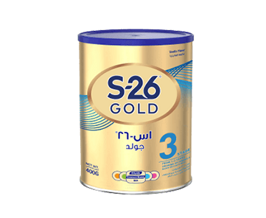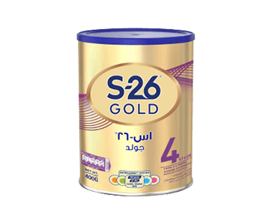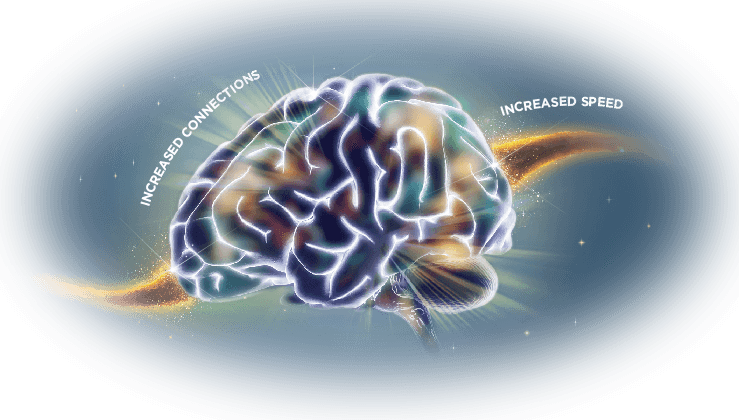S 26 Milk - Complete Nutrition for Your Child
Early childhood is a crucial period for learning and development as basic ways of thinking, responding, and solving problems are established.1-3 At this stage, you will notice your toddler’s ability to walk then run, express himself, and use his imagination.3,4 Behind these milestones are billions of neural connections forming in his brain which, along with his healthy physical growth, enable him to embrace and learn from every new encounter.5 Providing proper nutrition and stimulation at this critical time will positively impact how his brain and body develops, setting the stage for his learning and success, now and into the future.6,7S-26 GOLD 3, the FIRST & ONLY formula enriched with αlipids for faster brain connections and enhanced learning abilities, helping your child to analyze and understand faster.

S-26

Progress

 FOR FASTER BRAIN CONNECTIONS AND ENHANCED LEARNING ABILITIES, HELPING YOUR CHILD TO ANALYZE AND UNDERSTAND FASTER8-11Nutrition that supports fast brain connections can help in improving:
FOR FASTER BRAIN CONNECTIONS AND ENHANCED LEARNING ABILITIES, HELPING YOUR CHILD TO ANALYZE AND UNDERSTAND FASTER8-11Nutrition that supports fast brain connections can help in improving:





S-26 GOLD 3 is enriched with nutrients needed for fast brain connections to support your child’s developing brain.*

An essential nutrient for optimal brain & visual development17,18

An essential nutrient that helps support brain & memmory development19,20

May supports normal development of the eye21,22
CRITICAL MENTAL AND PHYSICAL MILESTONES* IN CHILDREN LESS THAN 5 YEARS ARE IMPORTANT2
 Starts to use things correctly (e.g., drinks from a cup, brushes hair)Gets to a sitting position without help
Starts to use things correctly (e.g., drinks from a cup, brushes hair)Gets to a sitting position without help Begins to sort shapes and colorsCan kick a ball
Begins to sort shapes and colorsCan kick a ball Can assemble puzzles with 3 or 4 piecesRuns easily
Can assemble puzzles with 3 or 4 piecesRuns easily Starts to understand timeCatches a bounced ball most of the time
Starts to understand timeCatches a bounced ball most of the time Says name and addressCan do a somersault
Says name and addressCan do a somersaultS-26® GOLD 3 OFFERS KEY NUTRIENTS NEEDED FOR OPTIMUM MENTAL DEVELOPMENT
 Brain development
Brain development Visual development
Visual development Supports brain development12-14 and improve mental processing speed15,16
Supports brain development12-14 and improve mental processing speed15,16 Facilitates cognitive function24 and normal development of visual function25
Facilitates cognitive function24 and normal development of visual function25 Important for nerve cell membranes and myelination26,27
Important for nerve cell membranes and myelination26,27 Improves mental development index29
Improves mental development index29 Improves cognitove test scores30
Improves cognitove test scores30 Required forbrain growth31
Required forbrain growth31 Amino acid required for brain growth28, 21
Amino acid required for brain growth28, 21 Amino acid required for brain growth27
Amino acid required for brain growth27
S-26® GOLD 3 OFFERS KEY NUTRIENTS NEEDED FOR OPTIMUM PHYSICAL DEVELOPMENT AND IMMUNITY


 Promotes normal growth and visual function, as well as healthy skin andtissue repair33
Promotes normal growth and visual function, as well as healthy skin andtissue repair33 Regulates the absorption of minerals like calcium33
Regulates the absorption of minerals like calcium33 Necessary for healthy bone development34
Necessary for healthy bone development34 Helps in production of blood and the building of muscles35
Helps in production of blood and the building of muscles35 Increases resistance to infection36,37
Increases resistance to infection36,37 Acts as an antioxidant, and boosts immune system38
Acts as an antioxidant, and boosts immune system38 Helps in many biological functions such as growth and immune function36,37
Helps in many biological functions such as growth and immune function36,37 May help fight viruses39
May help fight viruses39
HOW TO PREPARE?
Follow these easy mixing instructions for recommended serving size. Prepare S-26® GOLD 3 using only the enclosed scoop.S-26® GOLD 3
Per serving size of 240 mL/ 3 servings per day.
 7 scoops (42g powder)
7 scoops (42g powder) 210 mL lukewarm water
210 mL lukewarm water  240 mL
240 mL 
Wash your hands before preparing the milk.

Boil drinking water for five minutes. Allow to cool until lukewarm.

Mix approximately 39g of powder (3 heaping tablespoons) with 210 mL (7 fl. oz.) of previously

Stir until powder is fully dissolved.

Serve 2 glasses per day.
WARNING
Unboiled water or incorrect dilution can make your child ill. Incorrect storage, handling, preparation and feeding can potentially lead to adverse effects on the health of your child. Prepare only one serving at a time and follow the instructions exactly. Make sure your child consumes the milk immediately. Do not keep unfinished milk, discard the contents. Using more or less powder than indicated could either lead to dehydration or deprive your child of proper nutrition. Do not change proportions without medical advice.S-26® GOLD 3 AND S-26® GOLD 4 ARE NUTRITIONALLY SUPERIOR AND HOLISTIC COMPARED TO COW MILK AND MILK POWDERS*
 *Data per serving, 240 mL
*Data per serving, 240 mLLocator loading...
References: 1. UNICEF, WHO. Facts for Life | UNICEF.; 2010. Accessed October 27, 2021. https://www.unicef.org/reports/facts-for-life 2. Centers for Disease Control and Prevention. CDC’s Developmental Milestones | CDC. Accessed October 27, 2021. https://www.cdc.gov/ncbddd/actearly/pdf/parents_pdfs/milestonemomentsen… 3. Early childhood development | UNICEF. Accessed October 27, 2021. https://www.unicef.org/early-childhood-development 4. Santrok JW. Child Development. 13th ed. McGraw-Hill; 2011. 5. Sakai J. How synaptic pruning shapes neural wiring during development and, possibly, in disease. Proc Natl Acad Sci U S A. 2020;117(28):16096-16099. doi:10.1073/pnas.2010281117 6. Forbes TA, Gallo V. All Wrapped Up: Environmental Eects on Myelination. Trends Neurosci. 2017;40(9):572-587. doi:10.1016/j.tins.2017.06.009 7. What are the most important changes in the brain after birth? • ZERO TO THREE. Accessed October 27, 2021. https://www.zerotothree.org/resources/1379-what-are-the-most-important-… 8. Stiles J, Jernigan TL. The basics of brain development. Neuropsychol Rev. 2010;20(4):327-348. doi:10.1007/s11065-010-9148-4 9. Ortiz E, Pasquini JM, Thompson K, et al. Eect of manipulation of iron storage, transport, or availability on myelin composition and brain iron content in three dierent animal models. J Neurosci Res. 2004;77(5):681-689. doi:10.1002/jnr.20207 10. Georgie MK. Nutrition and the developing brain: Nutrient priorities and measurement. In: American Journal of Clinical Nutrition. Vol 85. Am J Clin Nutr; 2007. doi:10.1093/ajcn/85.2.614S 11. O’brien JS, Sampson EL, Brien O’, et al. Fatty acid and fatty aldehyde composition of the major brain lipids in normal human gray matter, white matter, and myelin*. J Lipid Res. 1965;6:545-551. doi:10.1016/S0022-2275(20)39620-6 12. Cilla A, Diego Quintaes K, Barberá R, Alegría A. Phospholipids in Human Milk and Infant Formulas: Benefits and Needs for Correct Infant Nutrition. Crit Rev Food Sci Nutr. 2016;56(11):1880-1892. doi:10.1080/10408398.2013.803951 13. Schneider N, J H, M O, et al. Sphingomyelin in Brain and Cognitive Development: Preliminary Data. eNeuro. 2019;6(4). doi:10.1523/ENEURO.0421-18.2019 14. Fields RD. White matter in learning, cognition and psychiatric disorders. Trends Neurosci. 2008;31(7):361-370. doi:10.1016/j.tins.2008.04.001 15. Yan J, Wiedeman AM, Grathwohl D, Lamers Y. Dietary choline-containing phospholipids are associated with cognitive performance in school-aged children. In: ESPGHAN. ; 2019. 16 Catani M, Allin MPG, Husain M, et al. Symmetries in human brain language pathways correlate with verbal recall. Proc Natl Acad Sci U S A. 2007;104(43):17163-17168. doi:10.1073/pnas.0702116104 17. Birch EE, Carlson SE, Homan DR, et al. The DIAMOND (DHA Intake and Measurement of Neural Development) Study: A double-masked, randomized controlled clinical trial of the maturation of infant visual acuity as a function of the dietary level of docosahexaenoic acid. Am J Clin Nutr. 2010;91(4):848-859. doi:10.3945/ajcn.2009.28557 18. Birch EE, Garfield S, Homan DR, Uauy R, Birch DG. A randomized controlled trial of early dietary supply of long-chain polyunsaturated fatty acids and mental development in term infants. Dev Med Child Neurol. 2000;42(3):174-181. doi:10.1017/S0012162200000311 19. Naber M, Hommel B, Colzato LS. Improved human visuomotor performance and pupil constriction after choline supplementation in a placebo-controlled double-blind study. Sci Reports 2015 51. 2015;5(1):1-9. doi:10.1038/srep13188 20. Cheatham CL, Sheppard KW. Synergistic Eects of Human Milk Nutrients in the Support of Infant Recognition Memory: An Observational Study. Nutr 2015, Vol 7, Pages 9079-9095. 2015;7(11):9079-9095. doi:10.3390/NU7115452 21. Alves-Rodrigues A, Shao A. The science behind lutein. Toxicol Lett. 2004;150(1):57-83. doi:10.1016/j.toxlet.2003.10.031 22. Vishwanathan R, Kuchan M.J., Johnson E.J. ACTA BIOLOGICA CRACOVIENSIA SERIES BOTANICA 16 th International Symposium on Carotenoids Towards a Brighter Side of Life. 2011;53:29. Accessed October 27, 2021. http://www.ib.uj.edu.pl/abc/abc.htm 23. Centers for Disease Control and Prevention. Childhood Nutrition Facts | Healthy Schools | CDC. Accessed October 27, 2021. https://www.cdc.gov/healthyschools/nutrition/facts.htm 24. Drover JR, Homan DR, Castañeda YS, et al. Cognitive function in 18-month-old term infants of the DIAMOND study: A randomized, controlled clinical trial with multiple dietary levels of docosahexaenoic acid. Early Hum Dev. 2011;87(3):223-230. doi:10.1016/j.earlhumdev.2010.12.047 25. Lien EL, Hammond BR. Nutritional influences on visual development and function. Prog Retin Eye Res. 2011;30(3):188-203. doi:10.1016/j.preteyeres.2011.01.001 26. Food and Nutrition Board I of M. Dietary Reference Intakes for Thiamin, Riboflavin, Niacin, Vitamin B6, Folate, Vitamin B12, Pantothenic Acid, Biotin, and Choline. Diet Ref Intakes Thiamin, Riboflavin, Niacin, Vitam B6, Folate, Vitam B12, Pantothenic Acid, Biot Choline. Published online June 15, 1998. doi:10.17226/6015 27. Morita J, Kano K, Kato K, et al. Structure and biological function of ENPP6, a choline-specific glycerophosphodiester-phosphodiesterase. Sci Reports 2016 61. 2016;6(1):1-14. doi:10.1038/srep20995 28. Bettler J, Zimmer JP, Neuringer M, Derusso PA. Serum lutein concentrations in healthy term infants fed human milk or infant formula with lutein. Eur J Nutr. 2010;49(1):45-51. doi:10.1007/s00394-009-0047-5 29. Oski FA, Honig AS. The eects of therapy on the developmental scores of iron-deficient infants. J Pediatr. 1978;92(1):21-25. doi:10.1016/S0022-3476(78)80063-8 30. Zimmermann MB, Connolly K, Bozo M, Bridson J, Rohner F, Grimci L. Iodine supplementation improves cognition in iodine-deficient schoolchildren in Albania: A randomized, controlled, double-blind study. Am J Clin Nutr. 2006;83(1):108-114. doi:10.1093/ajcn/83.1.108 31. Singh M. Nutrition, brain and environment: how to have smarter babies? - PubMed. Indian Pediatr. 2003;40(3):213-220. 32. Marshall K. Therapeutic Applications of Whey Protein. Altern Med Rev . 1996;9. 33. Riccioni G, D’Orazio N, Menna V, Lorenzo A De. Fat Soluble Vitamins and Immune System: An Overview: http://dx.doi.org/101177/1721727X0300100202. 2016;1(2):59-64. doi:10.1177/1721727X0300100202 34. Flynn A. The role of dietary calcium in bone health. Proc Nutr Soc. 2003;62(4):851-858. doi:10.1079/pns2003301 35. Iron | The Nutrition Source | Harvard T.H. Chan School of Public Health. Accessed October 27, 2021. https://www.hsph.harvard.edu/nutritionsource/iron/ 36. Wintergerst ES, Maggini S, Hornig DH. Immune-enhancing role of Vitamin C and zinc and eect on clinical conditions. Ann Nutr Metab. 2006;50(2):85-94. doi:10.1159/000090495 37. Maggini S, Wenzla S, Hornig D. Essential role of vitamin c and zinc in child immunity and health. J Int Med Res. 2010;38(2):386-414. doi:10.1177/147323001003800203 38. Vitamin E - Consumer. Accessed October 27, 2021. https://ods.od.nih.gov/factsheets/VitaminE-Consumer/ 39. Rayman MP. The importance of selenium to human health. Lancet. 2000;356(9225):233-241. doi:10.1016/S0140-6736(00)02490-9 40. Deoni S, Dean D, Joelson S, O’Regan J, Schneider N. Early nutrition influences developmental myelination and cognition in infants and young children. Neuroimage. 2018;178:649-659. doi:10.1016/j.neuroimage.2017.12.056 41. Nave KA, Werner HB. Myelination of the nervous system: Mechanisms and functions. In: Annual Review of Cell and Developmental Biology. Vol 30. Annu Rev Cell Dev Biol; 2014:503-533. doi:10.1146/annurev-cellbio-100913-013101 42. Shaer D.R., Kipp K. Developmental Psychology: Childhood and Adolescence - David R. Shaer, Katherine Kipp - Google Books. 9th ed.; 2013. Accessed October 27, 2021. https://books.google.ae/books?hl=en&lr=&id=qTgLAAAAQBAJ&oi=fnd&pg=PP1&d… qC491aayMdHn7yeGAteN5A&redir_esc=y#v=onepage&q&f=false 43. Saher G, Brügger B, Lappe-Siefke C, et al. High cholesterol level is essential for myelin membrane growth. Nat Neurosci. 2005;8(4):468-475. doi:10.1038/nn1426 44. Chida N, Hirono H, Arakawa T. Eects of Dietary Folate Deficiency on Fatty Acid Composition of Myelin Cerebroside in Crowing Rats. Tohoku J exp Med. 1972;108(3):219-224. 45. Calder PC. Functional Roles of Fatty Acids and Their Eects on Human Health. J Parenter Enter Nutr. 2015;39(1 Suppl):18S-32S. doi:10.1177/0148607115595980 46. Innis SM. Dietary (n-3) fatty acids and brain development. J Nutr. 2007;137(4):855-859. doi:10.1093/jn/137.4.855 47. Lozo B, Georgie MK. Iron Deficiency and Brain Development. Semin Pediatr Neurol. 2006;13(3):158-165. doi:10.1016/j.spen.2006.08.004

